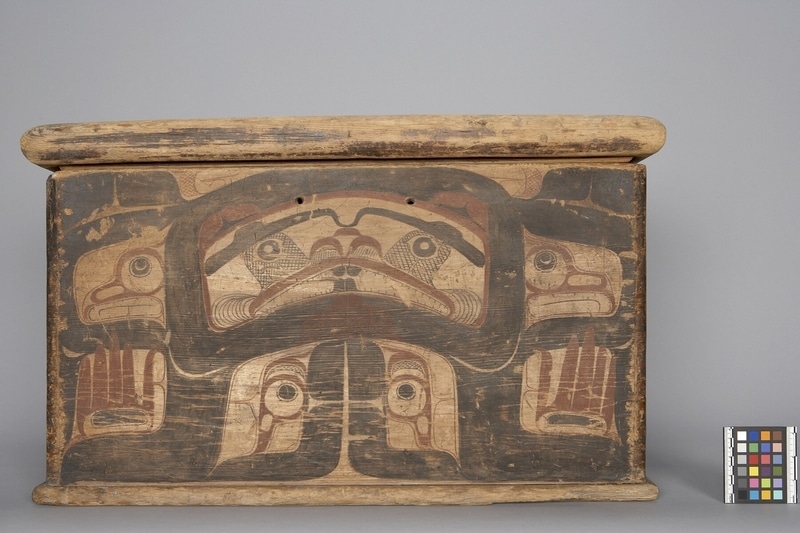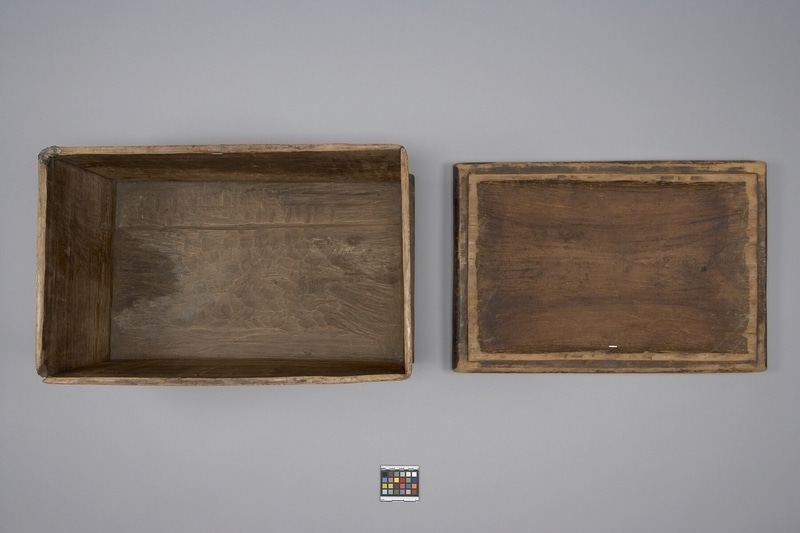Bentwood Chest Item Number: Nb3.1334 a-b from the MOA: University of British Columbia




Description
Bentwood chest with lid (part b). Painted distributive designs on all four sides, split symmetry on long sides. Heavy black formlines with red and black details. Complex designs on front and back; one short side has wide curving black bands with red outlined ovoids, split u's and a round eye shape; cross-hatched details. Other short side has wide curving black bands, a red circle shape to right, red split u's, ovoids and crosshatched details. Two drilled holes at top of each long side. Box lashed at one corner; metal patch nailed with square nails at top. Lid is thick and carved from a single piece of wood; rounded edges.
History Of Use
On the Northwest Coast, boxes are important symbols of wealth, power and rank, as well as, functioning as containers for food and valuables. Large decorated boxes or chests were owned by the wealthy to hold the material trappings of rank and prestige.
Iconographic Meaning
According to Duff, the imagery on boxes may be deliberately ambiguous to allow the owner to assign his own crest associations to the box. The crest figures on the box protect the items stored within. These protectors are said to inhabit the boxes on which they are portrayed. It may also be that the imagery on boxes is more complex than simple crest representations.
Cultural Context
storage; wealth; rank
Specific Techniques
Bentwood, or kerfed-corner, containers are constructed by a process unique to the Northwest Coast peoples. The carver begins with a single straight-grained plank of red cedar, or sometimes yellow cedar, spruce, or yew. The surface of the plank is finished with chisels, adzes, and knives; in earlier times, it was smoothed further with sandstone or dried sharkskin. Then three parallel kerfs, or grooves, are carved out at measured points across the width of the board, at right angles to the long edge. The kerfs, which will become three corners of the box, allow the board to be steamed until the wood fibres are softened, and then carefully bent to form a box with symmetrical sides. The final corner, as well as a fitted base, are joined and fastened with pegs (through drilled holes) or laced with spruce root or twisted cedar withes (branches). Storage boxes also have fitted lids of cedar, hollowed from the inside. Finally, painted compositions may be applied to the completed box and shallow carving added to bring the forms into relief. A well-made bentwood box is watertight. Historically, most boxes were used to store preserved foods and material goods; plain cooking boxes could be used to steam or boil food by adding water and heated stones.
Narrative
According to Roloff, and Peter Macnair, this chest and Nb3.1480 were both owned by a Salish woman on Vancouver Island (Comox or Duncan area) who had passed away c. 1984. Both chests are thought to have originated in the Bella Bella area, based on the style of painting.
Item History
- Made in British Columbia, Canada during 1850
- Collected in Vancouver Island, British Columbia, Canada
- Owned by Howard Roloff before November 22, 1985
- Received from Howard Roloff (Seller), Canadian Cultural Property Export Review Board (Funding source) and Museum of Anthropology Shop Volunteers (Funding source) on November 22, 1985
What
Who
- Culture
- Coast Salish and Heiltsuk
- Previous Owner
- Howard Roloff
- Received from
- Howard Roloff (Seller), Canadian Cultural Property Export Review Board (Funding source) and Museum of Anthropology Shop Volunteers (Funding source)
Where
- Holding Institution
- MOA: University of British Columbia
- Made in
- British Columbia, Canada
- Collected in
- Vancouver Island, British Columbia, Canada
When
- Creation Date
- during 1850
- Ownership Date
- before November 22, 1985
- Acquisition Date
- on November 22, 1985
Other
- Condition
- fair
- Accession Number
- 1089/0001 a-b